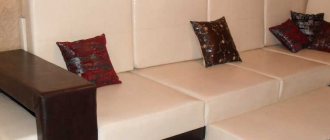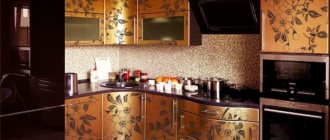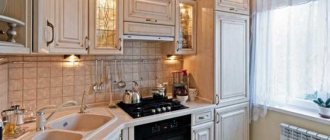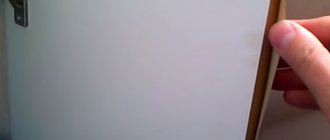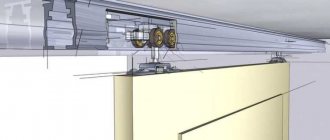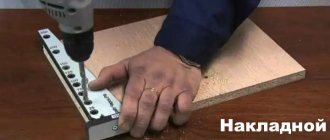0
68680
Beautiful, functional furniture is a must-have attribute of a home, office or apartment. Cabinet products in furniture production are decorated with facades treated with film material. A coating such as PVC film for furniture facades protects elements from moisture, scratches, damage and has an important decorative function. The coating allows you to implement many interesting ideas and design projects.
Lamination and lamination of chipboard. Chipboard technology.
Chipboard lamination and lamination technology.
Production of laminated chipboard. Decorative coating for furniture boards. To use chipboard in furniture production, sanded chipboard is subjected to decorative processing - a decorative coating of laminated paper (melamine) films is applied.
At this production site, sanded chipboard is converted into laminated chipboard. The production of laminated chipboards is the process of lining sanded chipboards with paper-based films (laminated paper films).
There are two methods for decorative processing of chipboards with paper-laminated films:
- Chipboard lamination.
- Chipboard lamination.
The main difference between lamination and lamination of chipboards is that during lamination, a decorative coating is created by chemical pressing and is a component of the board, while during lamination, a ready-made solid paper-resin film is glued to the board.
Where is matte PVC film used?
Matte furniture film is most often used for finishing furniture facades, including:
- built-in kitchens;
- cabinets;
- bathroom furniture;
- bedroom sets and much more.
Also, matte film for furniture facades is excellent for finishing horizontal surfaces, for example, kitchen countertops, computer or office tables.
The optimal thickness of the material allows it to be applied to shaped surfaces, for example, door trims and all kinds of decorative furniture elements.
Along with all of the above, the material is used for the design of molded products, in particular, all kinds of profiles - door, window, finishing, as well as baseboards.
Chipboard lamination.
Chipboard lamination is the process of covering board surfaces with paper-resin films impregnated with resins. The combined effect of pressure (25-28 MPa) and high temperature (140-210 ̊ C) causes the film to practically “grow” into the surface of the chipboard. The word “lamination” itself is of English origin and is translated as “layering, rolling, layering.”
Chipboard lamination line, made in China. (photo from website: china1.ru)
Fast lamination line. (photo: elo.ru)
| Feeding the slab into the press. | Multi-vacuum device with reversible strip for film laying. |
Chipboard lamination.
Chipboard lamination is the pressing of a cured film onto a chipboard. A layer of glue is applied over the entire surface of the slab and a hard decorative film is pressed onto this layer. The procedure for laminating chipboard slabs takes place under “milder” conditions than during lamination: under a pressure of 5-7 MPa and at a temperature of 120 -150 ̊C. The term "laminated" has German roots and comes from the German Kaschieren, which means "to paste over with paper."
Chipboard laminating line. (photo from the site: izoplit.ru)
Video of the process of laminating some slab material at one of the Chinese factories.
Laminated chipboard panels 10 mm thick.
Laminated chipboard. (photo from the site: woodkeep.ru)
| Interesting information. |
Some large factories for the production of serial furniture have their own chipboard laminating workshops to reduce the cost of finished products. Such factories purchase or produce sanded chipboard in small batches, saw it in this form, according to final dimensions, into parts in accordance with the technological map of a particular furniture product. Then a batch of such “raw” parts is sent to the laminating line. From there they get to the workshop, where holes are drilled in the already lined parts on special multi-spindle machines for installing fittings and assembling finished furniture. The chipboard cladding method - lamination - is used as it is somewhat technologically simpler and less expensive.
Packing chipboards on pallets.
In accordance with the requirements of the standard, the slabs are sorted and then either cut into blanks for furniture panels, or sent to consumers full-size.
Depending on the criteria for the appearance of the slab (cracks, chips, staining, stains, protrusions and depressions), laminated chipboard slabs are divided into the following grades:
- Laminated chipboard – 1st grade
(defects are not acceptable except minimal ones), - Laminated chipboard – 2nd grade
(large surface defects are acceptable), - without grade
(cardinal surface defects).
Methods of application
Polymer materials are a very popular finishing option; they provide neat facade decor and protection from many external factors. According to the method of application, PVC coatings are divided into the following types:
- Membrane-vacuum. The equipment used is a vacuum press, most often used for countertops, doors between rooms, cabinets, chests of drawers, bookshelves. Thickness - from a quarter to half a millimeter.
- Laminating. The process of gluing or pressing together two surfaces is called laminating. It is carried out using special equipment. It is used for various surfaces made of fiberboard and MDF, including window sills. The thickness of the cladding usually does not exceed three tenths of a millimeter.
- For lamination. Cladding is done on a machine because work is usually carried out on fairly long elements made of metal, plastic or wood in order to protect them from water and give them strength. Two-layer PVC film provides more complete protection from influences, including sun rays.
- Transparent. This type of material is very thin, almost like food grade, it does not perform its functions for too long, but it stretches well, and it is convenient to completely cover the product. Usually it is chosen for transporting something, securing it to the surface of the cargo with glue that does not leave any traces behind.
- For chipboard and MDF. Intended for individual parts, for example, ends. A special machine is used to stretch it, so it is difficult for a beginner to achieve good quality at home, although some craftsmen try to do this, using, for example, a hair dryer.
Updating the interior with recessed furniture lamps
Film can be applied to surfaces in different ways:
- Laminating. This process has several subspecies, differing in temperature. Smooth elements are processed using the cold method, glue is applied to them, and then the coating is rolled under pressure. During warm processing, the glue is preheated to melt off excess water. The hot type of finishing is carried out at a temperature of 120-160 degrees, using heated rolling rollers.
- Lamination. In this case, no glue is used; the fastening effect is exerted by heat and pressure, which make the substance plastic. The result is a solid, non-delaminating fabric. Waste material is subject to recycling and reuse.
- Post-formation. The most effective option. The layered coating is applied to a base coated with glue on a positioning machine. The press used has a relief that gives the finished product an interesting texture.
Glossy PVC film is usually applied using a vacuum method.
Every technology has its limitations. For example, when laminating, it is imperative that the object be smooth, without protruding fragments or nicks. During post-formation, it must withstand the load that the equipment will place on it.
Features of decoupage furniture using various materials
In general, polyvinyl chloride film for furniture facades is easy to use and has many advantages. It not only gives the furniture a glossy and presentable appearance, but also saves it from accidental damage and premature aging, chemical, thermal and other influences.
For chipboard and MDF
Membrane-vacuum
Transparent
Melamine film for chipboard cladding.
Melamine films are a modern facing material based on decorative papers of various densities (plain or printed), impregnated with amino-formaldehyde resins with an incomplete degree of polycondensation. (photo from website: bimma.ru)
To obtain a melamine film, you need to impregnate special decorative paper with resin. Impregnation occurs in several stages. On an impregnation machine, resin is first applied with a roller to the underside of the canvas, and then the paper is completely immersed in the resin in the bath. Between the first and second stages of impregnation, the paper passes through a “penetration” zone. As this zone passes through, the resin applied to the underside penetrates the paper and displaces the air from the paper. Thanks to the displacement of air, good saturation of the middle of the paper is achieved in the future.
After the first impregnation machine, the paper is dried, resulting in the removal of volatile substances. Then the fabric enters the second impregnation machine. There, a layer of melamine-formaldehyde resin is applied to both sides of the paper sheet. The purpose of applying a second layer of resin is to give the top layer increased fluidity properties during pressing, as well as to give the facing surface smoothness and increased strength.
The paper then goes into another dryer, which has three heating zones and one cooling zone. Once in the cooling zone, the film sheet enters a roller conveyor (roller table), the rollers of which are cooled by water. This is how paper turns into film. After this, the film is cut into sheets of a given size. These film sheets are stacked on a sheet stacker and packaged.
How to repaint laminated furniture with your own hands
The question “How to paint laminated furniture with your own hands?” worries those who have decided to update their interior and save money at the same time. And is it even possible to repaint furniture that is considered “disposable”? Furniture made from laminated MDF and chipboard is a budget option that can be easily replaced with a new one with a different color, texture and shape.
However, craftsmen easily take on the task of repainting laminated furniture with their own hands. And if you have the necessary tools and knowledge, this is not at all difficult to do.
We repaint laminated furniture with our own hands - stages of work
Stage 1 - Preparatory
The laminated surface of any furniture is plastic (polyvinyl chloride, PVC), resistant to water. If you paint such a smooth surface, the paint will not stick, even the most expensive and high-quality one. Therefore, the surface must be carefully prepared. First, you should remove all fat from the surface using special solvents and detergents.
To make work more convenient, it is better to disassemble the furniture. But if you only need to repaint the facades, then you can remove only them from their hinges and lay them on a horizontal surface. If the fittings are not removed during painting, then it makes sense to protect them with masking tape.
Stage 2 - Sanding the surface
To prevent the paint from falling off after application, the top layer must be removed from the laminated surface. Sandpaper is suitable for this. First, you should use a coarser-grain sandpaper to remove the laminating layer, and then sand the furniture with a fine-grain sandpaper. This treatment will create a rough surface on which the paint will adhere better.
Do not forget to use personal respiratory protection when working, as dust from plastic is quite harmful.
Stage 3 - Sealing cracks
To seal cracks and chips, you need to use either a special composition based on epoxy resin or putty (preferably latex). Before treating cracks, they must be primed and allowed to dry. Then the cracks are sealed and the composition is also allowed to dry completely. A small spatula is used as a tool.
Stage 4 - Surface priming
Priming is a mandatory step before painting. A good quality primer will prevent the paint from peeling and bubbling. Give preference to a polyurethane-based primer; this composition sticks to everything, even glass and ceramic tiles.
If such a composition is not available, then you can purchase a primer in cans intended for painting a car. But when working in it, the presence of a respirator becomes a prerequisite. The soil must dry for at least 12 hours.
If you plan to paint the furniture in a specific color, then the primer can also be tinted in the selected shade to create some kind of “background”.
Stage 5 - Painting
Which paint to choose for laminated furniture? This is the first question that craftsmen ask before painting. Of course, it is better to give preference to special paints marked “for furniture,” but alkyd or polyurethane paints are also an excellent solution. But epoxy-based paints, although they give excellent results, take a long time to dry and stink. You can use such paints only if painting takes place somewhere in a garage or shed.
Chalk paint would be an excellent solution, especially since you can make it yourself.
To paint furniture made of laminated chipboard, you can also choose acrylic paints, but in this case you will have to prime it at least twice beforehand.
As a tool, choose a short-pile velor roller - such rollers paint much better than foam rollers and create an even layer. For hard-to-reach places, such as corners, choose brushes of different sizes (you’ll have to check which one is convenient for you - you’ll have to check it in practice).
So, you will have to paint in two layers, allowing the first layer to dry thoroughly. If suddenly for some reason something cannot be painted over, then this place can be decorated, for example, using the decoupage technique.
Stage 6 - Protection
If repainted furniture is exposed to active moisture or wear (for example, kitchen facades or furniture in the hallway), then applying varnish over the paint would be an appropriate solution. Choose acrylic varnish; both glossy and matte varnishes are available. The varnish is applied either with a brush or a roller to completely dry paint.
So, painting laminated furniture with your own hands is not difficult, especially if you know all the nuances. And after proper preparation, you will actually end up with new furniture, perhaps even better than the old one. And, what can I say, this will still help you save on buying new furniture and get a truly exclusive item.
Types of coatings
For the kitchen, the best choice would be MDF furniture. And the point is not even in its greater density, but in the high homogeneity of the composition. Unlike chipboard, the material does not crumble and holds fasteners well, even repeated ones, which is extremely important when replacing hinges, handles or other fittings. In addition, the manufacturing method itself is based on lignin, and not formaldehyde resins, which makes MDF facades more environmentally friendly.
The slab is decorated in a variety of ways.
- Veneer is a section of natural wood glued to a slab. It requires exactly the same care as a real tree, is just as capricious and just as beautiful. If damaged, this coating cannot be restored with your own hands.
- PVC film is most often used for laminating chipboard, since this is the most budget option. The film can imitate any type of wood, although not entirely convincingly. The main disadvantage is that with prolonged exposure to moisture and temperature, the film peels off. Repair is partially possible.
- Melamine film - its basis is decorative paper impregnated with melamine resin. The advantage of such kitchen facades is their higher resistance to moisture.
- Acrylic film is a paper-laminated plastic, characterized by much higher strength, resistance to mechanical damage and dampness. This coating can have a matte, satin or glossy surface, and therefore extremely rarely imitates wood. Any colors are available - white, red, blue, black and all possible combinations.
As a result, it is possible to re-tighten PVC film with your own hands, but not melamine or acrylic film.
Repairs of this kind are possible only in small areas and only in cases where the film has only peeled off and has not become deformed, as happens from overheating. In the latter case, it is easier to remove the entire coating or order a new kitchen façade.
To remove the defect, put PVA, “Moment”, “Titan” glue into a medical syringe - without a needle - and carefully fill the cavity under the film. You can also use “liquid nails”. The film is stretched, smoothed so that no air bubbles remain, and secured with tape for 4 hours.
In case of extensive damage, restoration of kitchen facades is impossible.
Kitchen facades made of chipboard
For the manufacture of cabinets, laminated panels with a thickness of 2-4 cm are used. During the pressing process, they can be given a fairly high density, which has a positive effect on the strength characteristics of the furniture itself. But for doors and kitchen drawer fronts, the optimal panel thickness is 16 mm. This is the ideal size for mounting fasteners and decorative fittings with sufficient resistance of the slab to mechanical loads.
Lamination technology has a significant impact on the durability of kitchen facades. The weakest point of laminated chipboard products is the edges. Once the coating on them is damaged, such furniture will only last for a year or two. So various methods of processing and protecting the ends of pressed panels are used:
- Acrylic or PVC furniture edging is the most short-lived option for the kitchen. However, you can regularly update it yourself. It is not difficult to find strips of the required width on sale, and they are glued using a regular iron.
- Postforming is a relatively new technology that involves wrapping facades with a solid sheet of plastic, without seams or joints. This solves the main problem of pressed slabs in the kitchen - moisture permeability from the edges. A similar technique is used in the manufacture of chipboards for window sills.
- Aluminum profile - under such overlays the chipboard can be sealed with the thinnest and most unreliable film. The metal frame will ensure its complete safety, and the headset will have an original appearance and a long service life.
The front parts of laminated chipboard are also decorated differently. Ideally, the film should literally be sintered under high pressure along with the pressed board. But today you can often find very low-cost options with so-called lamination - simple pasting with multi-layer paper impregnated with polymer resin.
Kitchen painting
You can paint MDF facades with everything, with the exception of options with an acrylic panel. This kind of repair requires great care and some experience. Especially if you need to paint a complex surface - milled or radius.
The renovation consists of three stages: choosing paint, preparing and painting.
Selection of paints and varnishes
To paint MDF boards, ordinary acrylic or oil paints can be used. Alkyd compounds are better in quality and more durable. The ideal option for the kitchen are polyurethane paints and our own polyurethane primer.
1. Water-based polyurethane primer is absorbed by the top layer of the material, shrinks the loose surface, imparting sufficient strength and smoothness. This coating is easy to sand and significantly reduces the consumption of paint and varnish.
If fairly old kitchen facades are being repaired, it is highly recommended to apply a second layer of filler primer.
2. Polyurethane enamels are distinguished by a rich range of colors and provide varying degrees of gloss. The following paints are produced:
- matte – with a minimal degree of light reflection;
- semi-matte;
- semi-gloss – this coating is recommended for pastel colors;
- glossy - the most popular;
- high-gloss – suitable for very pure and bright colors, as they provide an almost mirror-like shine. The white gloss will be simply dazzling.
3. Varnish. Acrylic and polyurethane varnishes are used. The former are transparent and do not turn yellow over time, but are inferior in mechanical strength to polyurethane ones.
Preparation of material
If the facades are really old, the surface includes not only peeling of film and paint, but also chips and cracks.
If the dimensions of the sash have changed, for example due to constant dampness, then it is advisable to abandon the restoration. It will be much faster and cheaper to completely renovate the kitchen.
If you decide to radically change the design of the kitchen, then do-it-yourself renovation is quite possible.
- The hinges and handles are removed from the sash.
- Get rid of the film coating. Since PVC film and melamine film are not resistant to heat, the facades are simply heated with a hairdryer and the film is removed. This cannot be done with an acrylic panel.
- The old layer of enamel is removed with a solvent.
- The surface is polished using sanding sponges, brushes or a sander. The treatment removes glue and paint residues, minor scratches and chips. Grinding is carried out in three stages using abrasive materials with coarse grains - P180, medium and fine.
- Then the part is cleaned of dust and primed. This is best done with a spray, but you can use a roller or even a brush. The primer dries in about 8–10 hours.
- After drying, the surface must be cleaned again with the finest grain abrasive.
The process of preparing the material is covered in detail in the video.
Pros and cons of using
PVC film for furniture facades has a number of significant advantages:
- combination of strength with high elasticity, which prevents tearing of the material during use;
- water resistance;
- low thermal conductivity;
- resistance to many chemicals, deformation, heat and cold;
- there is no fading because the material is impervious to ultraviolet radiation, that is, even when exposed to direct sunlight it will not fade;
- favorable cost, especially in comparison with simulated materials - stone, wood, marble;
- high-quality drawings, interesting textures, impressive appearance of films.
Due to its resistance to moisture and heat, PVC can even be used in the interior of a kitchen or bathroom, where other materials would quickly begin to deteriorate.
However, one cannot fail to note the possible disadvantages:
- self-adhesive PVC film may begin to peel off or bubble if it cannot withstand constant changes in temperature, humidity, and direct rays of the sun;
- sometimes it breaks or is accidentally cut with a knife, then the coating cannot be restored or a separate fragment can be replaced without losing aesthetic qualities, everything has to be re-glued.
Features of using stickers on furniture, choice of materials and themes
In order not to spoil the self-adhesive PVC film, it is better not to clean it with abrasive materials (a sponge with soapy water is perfect), not to cut anything on it with sharp objects, not to expose it to too much heat or cold, sudden changes in temperature. Despite the fact that it must withstand this, its service life will increase significantly if these simple rules are followed.
